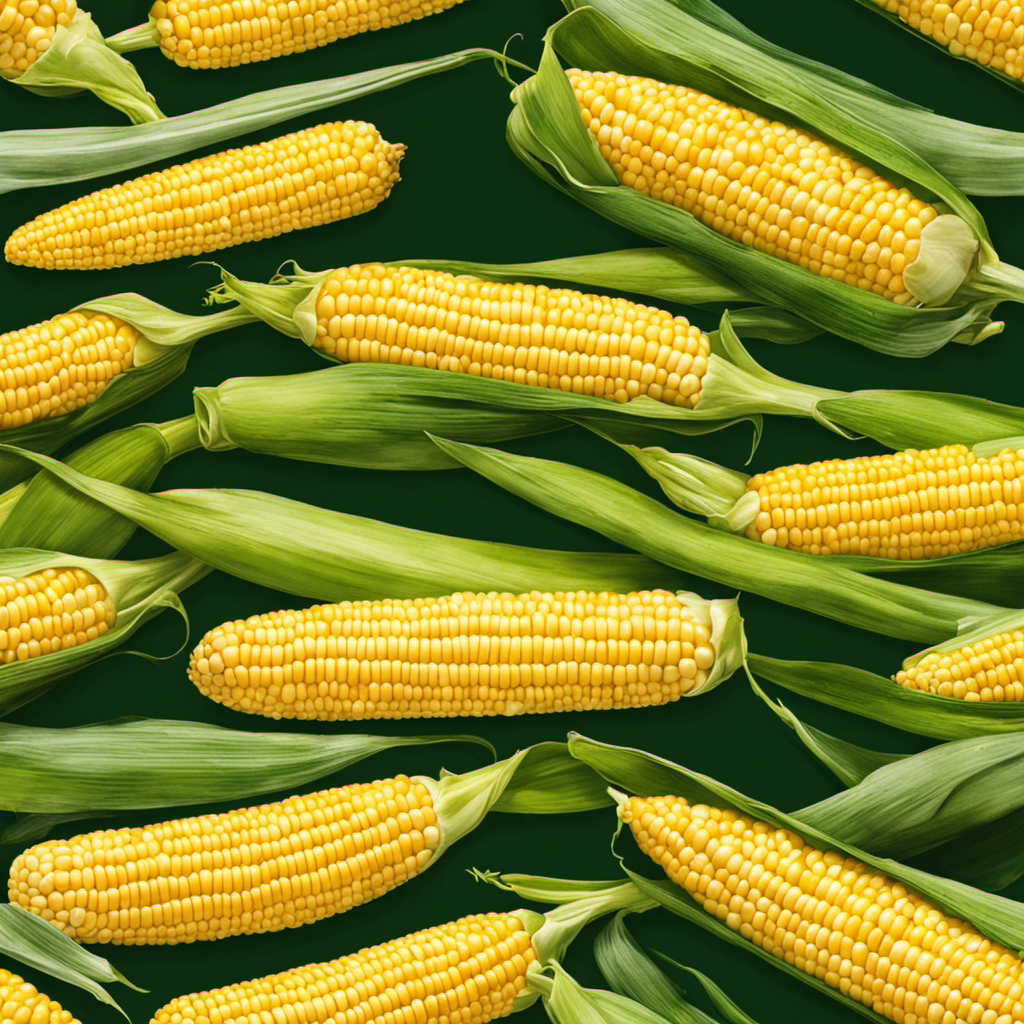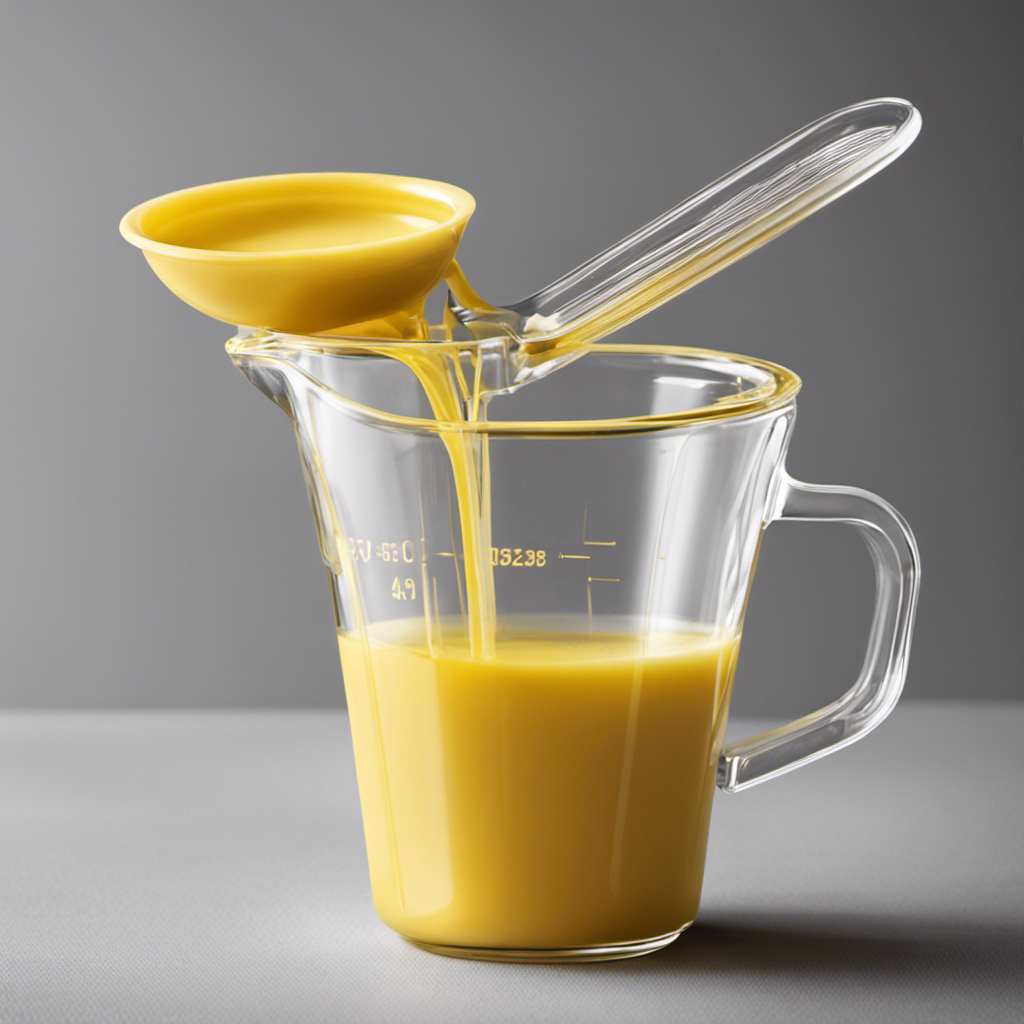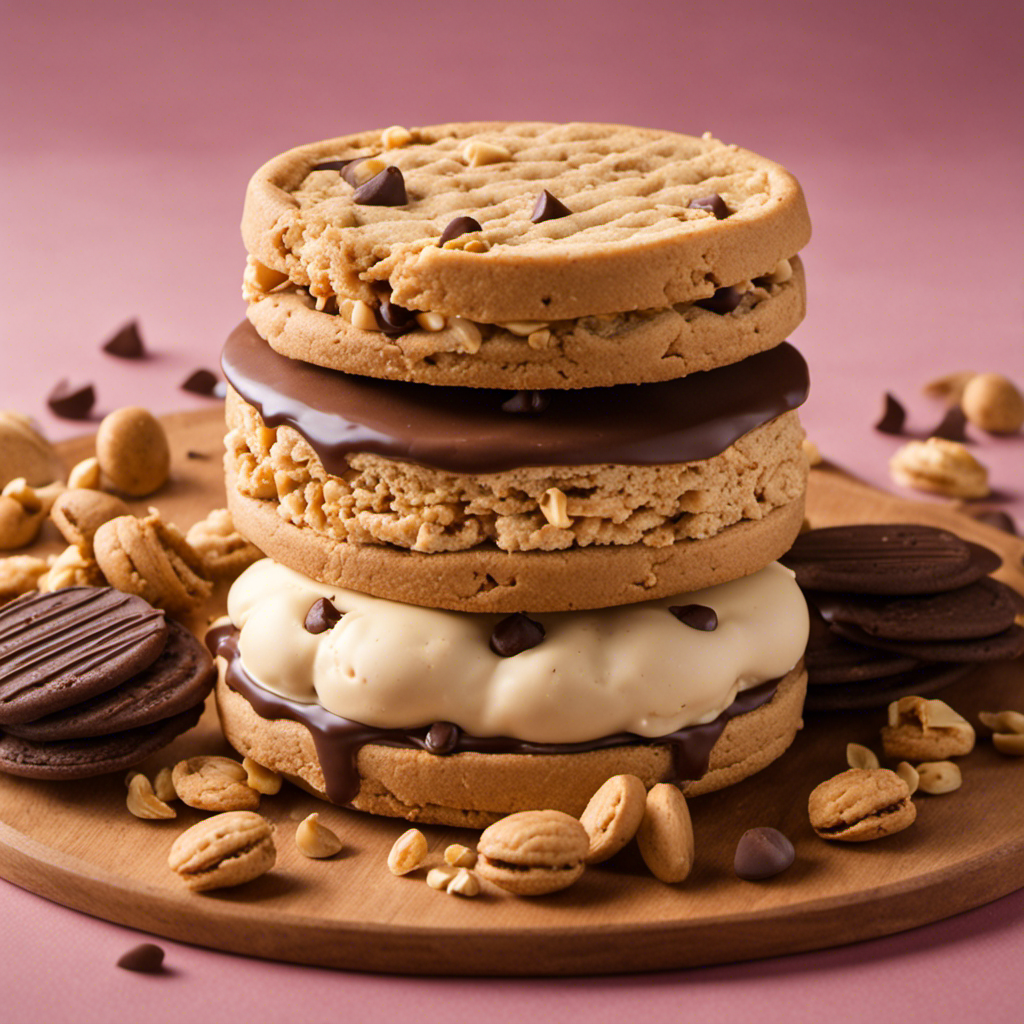Have you ever been curious about the secret to making sweet corn that’s perfectly buttery and delicious? Look no further, because I have the answer for you.
In this article, I’ll guide you step-by-step on how to cook sweet corn with butter, using simple techniques that will elevate your corn game to a whole new level.
From selecting the perfect corn to serving it up with a generous amount of butter, get ready to indulge in this summertime staple like never before.
So, are you ready to take your sweet corn to new heights?
Key Takeaways
- Select fresh and bright green sweet corn with firm husks
- Boil, grill, or steam sweet corn to cook it
- Enhance the flavor of sweet corn with butter and various seasonings
- Experiment with different cooking techniques and flavor pairings for grilled sweet corn
Selecting the Perfect Sweet Corn
When selecting the perfect sweet corn, make sure it feels firm and has bright green husks. This indicates that the corn is fresh and juicy. Avoid corn with dry or wilted husks, as it may be past its prime.
There are several different varieties of sweet corn to choose from, each with its own unique taste and texture. Some popular varieties include yellow, white, and bi-color corn.
It’s important to store sweet corn properly to maintain its freshness. Keep it refrigerated and consume it within a few days for the best flavor. Alternatively, you can freeze sweet corn by blanching it first and then placing it in airtight containers. This way, you can enjoy the taste of sweet corn long after the harvest season is over.
Preparing the Corn for Cooking
When it comes to preparing sweet corn for cooking, there are a few key points to keep in mind.
First, start by shucking and cleaning the corn to remove the husks and silk.
Then, decide whether you want to boil or grill the corn, depending on your personal preference.
Shucking and Cleaning
First, grab a fresh ear of sweet corn and remove the husk and silk before cleaning it thoroughly. To husk the corn, simply peel back the outer green leaves, one by one, until you reveal the beautiful golden kernels beneath.
Once the husk is removed, you will notice the sticky silk strands clinging to the corn. To remove the silk, grab a firm grip on the silk end and pull it down in one swift motion. If any silk remains, use a soft-bristled brush or your fingers to gently remove it.
After husking and silk removal, rinse the corn under cool water to wash away any dirt or residue. Now your sweet corn is ready to be cooked and enjoyed!
Boiling or Grilling
To boil or grill, simply place the prepared corn on the preheated grill or in a pot of boiling water and let it cook for about 5-7 minutes until it becomes tender.
Boiling and grilling are two popular methods for cooking sweet corn, each offering its own unique flavor and texture. Here are some key points to consider:
-
Boiling: This method involves submerging the corn in boiling water, which helps retain its natural sweetness and juiciness. It is a quick and easy way to cook corn, ideal for large batches or when you’re short on time.
-
Grilling: Grilling corn gives it a smoky and charred flavor, enhancing its natural sweetness. The direct heat caramelizes the sugars, resulting in a deliciously charred and slightly crispy texture.
-
Steaming: While not mentioned in the initial instructions, steaming is another cooking method that can be used for sweet corn. It involves placing the corn in a steamer basket over boiling water, which helps retain its nutrients and produces a tender and juicy result.
-
Toppings: After boiling or grilling, you can enhance the flavor of your sweet corn by adding additional toppings such as butter, salt, pepper, or even a sprinkle of cheese. These toppings complement the natural sweetness of the corn and take it to the next level of deliciousness.
Butter and Seasoning
For added flavor, you can easily enhance your corn by generously spreading some creamy butter and sprinkling your favorite seasonings over it. Butter not only adds richness but also helps to bring out the natural sweetness of the corn. When it comes to melting the butter, there are a few techniques you can try. One option is to melt the butter in a small saucepan over low heat until it becomes liquid. Another technique is to place a few tablespoons of butter in a microwave-safe bowl and heat it in short bursts until it melts. As for preferred butter brands, it ultimately depends on personal preference. Some popular options include Kerrygold, Land O’Lakes, and Plugrá, all of which have a rich and creamy taste that pairs well with sweet corn.
| Butter Brand | Creaminess | Richness |
|---|---|---|
| Kerrygold | High | High |
| Land O’Lakes | Medium | Medium |
| Plugrá | High | High |
Boiling Sweet Corn
While boiling sweet corn, make sure to add a pinch of salt to enhance the flavor. This simple step can make a big difference in the taste of your corn.
To further improve your boiling technique and achieve perfectly cooked corn every time, consider the following corn cooking hacks:
-
Use a large pot: This allows the corn to cook evenly and prevents overcrowding.
-
Boil for just the right amount of time: Overcooking can result in mushy corn, while undercooking may leave it tough. Aim for 8-10 minutes for tender, crisp kernels.
-
Add a touch of sugar: Some people swear by adding a teaspoon of sugar to the boiling water to bring out the natural sweetness of the corn.
-
Ice bath for crispness: After boiling, dunk the corn in a bowl of ice water to stop the cooking process and lock in the crispness.
Grilling Sweet Corn
Grilling sweet corn gives it a delicious smoky flavor that can’t be replicated with other cooking methods. It’s my favorite way to enjoy this summer staple. To make the most of grilling sweet corn, I’ve learned a few techniques that ensure perfectly cooked and flavorful corn on the cob. First, I like to soak the corn in water for about 30 minutes before grilling to prevent it from drying out. Then, I peel back the husks, remove the silk, and spread butter on the corn. I fold the husks back over the corn and tie them with kitchen twine to create a neat package. Finally, I grill the corn over medium-high heat for about 15-20 minutes, turning occasionally. The result is tender, smoky corn with a hint of buttery goodness.
Here’s a table comparing grilling techniques and corn on the cob alternatives:
| Grilling Techniques | Corn on the Cob Alternatives |
|---|---|
| Soaking the corn in water before grilling helps prevent drying out. | Boiling: Quick and easy, but lacks the smoky flavor. |
| Spreading butter on the corn before grilling adds a delicious richness. | Microwaving: Convenient, but can result in uneven cooking. |
| Folding the husks back over the corn and tying them with kitchen twine creates a neat package. | Roasting: Intensifies the flavor, but takes longer than grilling. |
| Grilling the corn over medium-high heat for 15-20 minutes ensures tender and smoky corn. | Steaming: Retains moisture, but doesn’t add smoky flavor. |
Oven-roasting Sweet Corn
When it comes to oven-roasting sweet corn, there are a few key points to consider: the ideal cooking temperature, cooking time variations, and butter melting techniques.
Finding the perfect cooking temperature is crucial for achieving the desired tenderness and flavor.
Additionally, understanding how cooking times can vary depending on factors like corn size and oven efficiency will help ensure consistent results.
Lastly, knowing the best techniques for melting butter and incorporating it into the roasted corn will enhance the overall taste and presentation of the dish.
Ideal Cooking Temperature
To achieve the ideal cooking temperature for sweet corn, you’ll want to preheat the grill to medium-high heat. This will ensure that the corn kernels are cooked through while also developing a nice charred flavor.
Here are some cooking techniques and flavor pairings to enhance your grilled sweet corn experience:
-
Direct grilling: Place the corn directly on the grill grates for a smoky and charred flavor.
-
Indirect grilling: Wrap the corn in aluminum foil and cook it indirectly on the grill to retain its moisture and sweetness.
-
Seasonings: Brush the corn with melted butter, sprinkle it with salt and pepper, or experiment with other seasonings like chili powder, garlic powder, or lime juice.
-
Flavor pairings: Serve grilled sweet corn with a pat of butter, a squeeze of lime, or sprinkle it with crumbled cheese like feta or cotija for added richness and tanginess.
With these cooking techniques and flavor pairings, you’ll elevate your grilled sweet corn to a whole new level of deliciousness. Enjoy!
Cooking Time Variations
When it comes to cooking sweet corn with butter, there are a few variations in cooking time depending on your personal preference. If you prefer your corn to be crisp and slightly crunchy, boiling it for about 4-5 minutes should do the trick. On the other hand, if you like your corn to be more tender and juicy, boiling it for 8-10 minutes will give you that desired texture. It’s all about finding the balance that suits your taste buds.
Now, let’s talk about flavoring options. While butter is a classic choice for seasoning sweet corn, you can also experiment with different herbs and spices to enhance its taste. Some popular options include adding a sprinkle of salt, a dash of black pepper, or a squeeze of lime juice for a tangy twist. These additions can elevate the flavor of your sweet corn and make it even more delicious.
Speaking of butter, let’s move on to the next section and discuss different butter melting techniques.
Butter Melting Techniques?
If you want your butter to melt quickly and evenly, microwave it in short bursts, stirring in between, until it reaches a smooth and creamy consistency. This is one of the most effective melting techniques for butter. However, the temperature of the butter plays a crucial role in achieving the desired results.
Here are some important factors to consider:
- Room temperature butter melts more evenly than cold butter.
- Softened butter at around 70°F (21°C) is ideal for melting.
- Avoid microwaving butter at high power for long periods as it can easily overheat and become greasy.
- If you don’t have a microwave, you can melt butter on the stovetop using low heat, stirring constantly.
Serving and Enjoying Sweet Corn With Butter
Once the sweet corn is cooked, you can generously slather it with butter and savor the deliciousness.
There are various serving techniques you can use to enhance your enjoyment of this classic summer dish.
One popular method is to serve the corn on the cob, allowing everyone to hold their own piece and bite into the juicy kernels.
Another option is to cut the kernels off the cob and serve them in a bowl, which makes it easier for younger children or those with braces to enjoy.
As for the nutritional benefits, sweet corn is a good source of fiber, vitamins, and minerals.
It is also low in calories and fat when prepared without excessive butter.
Frequently Asked Questions
Can I Use Frozen Sweet Corn Instead of Fresh Corn for These Cooking Methods?
Yes, you can use frozen sweet corn instead of fresh corn for these cooking methods. However, using fresh corn has its benefits, such as a sweeter taste and better texture.
How Long Does It Take to Grill Sweet Corn on a Charcoal Grill?
Grilling sweet corn on a charcoal grill usually takes about 10-15 minutes. The charcoal heat gives the corn a smoky flavor that pairs perfectly with butter. It’s a simple and delicious side dish.
Should I Remove the Silk From the Corn Before or After Cooking?
I always remove the silk from corn before cooking. It’s safe to eat, but removing it gives a cleaner taste. As for husking, I prefer to do it after cooking for an easy and delicious treat.
Can I Use Margarine Instead of Butter for Serving Sweet Corn?
I prefer using butter instead of margarine when serving sweet corn. Butter adds a richer flavor and enhances the natural sweetness of the corn. However, you can use margarine as a substitute if desired.
Is It Necessary to Soak the Corn in Water Before Grilling or Roasting It?
Soaking sweet corn before grilling or roasting enhances its flavor and tenderness. Fresh corn offers numerous health benefits, and it can be seasoned in various ways. Additionally, there are alternative cooking methods available for cooking sweet corn.
Conclusion
In conclusion, cooking sweet corn with butter is like a harmonious dance between two long-lost lovers. The sweetness of the corn and the richness of the butter come together in perfect unity, creating a symphony of flavors that will delight your taste buds.
Whether you choose to boil, grill, or oven-roast your corn, the end result will be a delicious and satisfying dish that will transport you to a world of culinary bliss.
So go ahead, embrace the magic of sweet corn and butter, and experience a culinary love story like no other.










